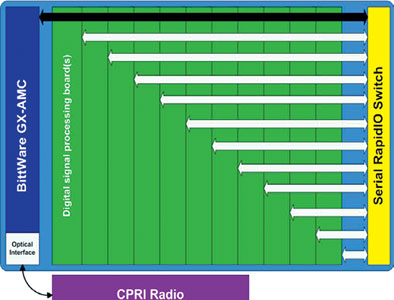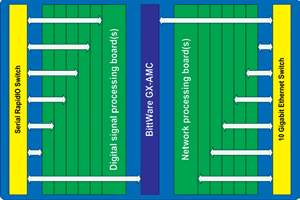
MicroTCA is an inherently flexible industrial computing standard. When coupled with a reconfigurable advanced mezzanine card (AMC), this flexibility is enhanced, providing designers with an extensive array of options.
This article discusses what makes MicroTCA an inherently flexible standard, the requirement and definition of a reconfigurable AMC, and combining reconfigurable AMCs with custom backplanes to further extend this flexibility.
Technology in the current day moves faster than ever before; standards are constantly changing. The flexibility of a given technology is now of the utmost importance. Flexibility enables hardware and system designers to build a large number of systems using the same design, and to easily adapt the hardware for future requirements, without having to initiate frequent redesigns, extending product lifecycles and hardware re-use.
The MicroTCA bus standard was created in 2006 to provide a flexible and open platform for telecom and datacom equipment. Although MicroTCA was originally created for telecommunications, its flexibility and small size have made it attractive across multiple industries. Even military and defence contractors have taken an interest now that there is a ruggedisation path for the standard, currently in progress within PICMG. The standard provides a backplane for off-the-shelf or custom AMCs that support GPPs, DSPs, FPGAs, I/O standards and storage, with the supplier list for each growing daily.
Inherent flexibility
MicroTCA racks are available in various shelf sizes including single tier, two tier single (mixed width), cube, pico and custom. The standard supports multiple switch fabrics such as Serial RapidIO, PCI Express, and 10 Gigabit Ethernet.
MicroTCA also allows for endless custom backplane possibilities, further enhancing flexibility. For example, the backplane can be divided into different switch fabric zones, providing multiple fabrics. Direct point-to-point connections enable a switchless backplane, or a combination of switched and non-switched can be used. The rear panel I/O enables rear transition modules.
Extending flexibility
The inherent flexibility of MicroTCA can be expanded further with the availability of reconfigurable AMCs and custom back-planes. For an AMC to provide complete re-configurability, it should support configurable switch fabric interfaces, AMC clocking for system synchronisation and clocking options, front and rear panel I/O, and processing.
The configurable switch fabric interfaces should support standard switch fabrics, protocols and multiple port connections. This enables bridging of switch fabrics, bridging of protocols, and bridging of protocols to switch fabrics. Supported switch fabrics can include Serial RapidIO, 10 Gigabit Ethernet and PCI Express. Protocols can include Common Public Radio Interface (CPRI), Open Base Station Standard Initiative (OBSAI), System Physical Interface Level 4 (SPI-4), Aurora and Serial Lite.
A reconfigurable front and rear panel I/O can provide various physical interfaces, enabling communication between legacy systems and the MicroTCA system, connections to existing devices, and an interface to non-switch fabric-based systems. The front panel should provide a physical interface by way of plug-on modules for adaptability with available space dictated by AMC size. The rear panel should make use of available AMC ports with a physical interface provided by a rear transition module.
Last but not least, an architecture that allows for reconfigurable processing should support various types of processing. This can be achieved by using an FPGA as a configurable processor for pre- and/or post-signal processing, compression and coding.
Reconfigurable AMC
BittWare's GX-AMC (GXAM) is an FPGA-based AMC that is in-system reconfigurable via a control plane interface to the host, providing a front panel module for adaptable I/O, and fully connected to all AMC clocks and ports.
Based on Altera's Stratix II GX FPGA, BittWare's GXAM is a mid-size, single wide AMC that can be used in MicroTCA systems and attached to AdvancedTCA carriers or other cards equipped with AMC bays. The GXAM features a high-density Altera Stratix II GX FPGA, BittWare's ATLANTiS framework (implemented in the FPGA), a front panel I/O interface, a control plane interface via BittWare's FINe interface bridge, an IPMI system management interface, a configurable 11x SerDes interface supporting a variety of protocols and rear panel I/O. It also provides 10/100 Ethernet, Gigabit Ethernet, two banks of DDR2 SDRAM, one bank of QDR2 SRAM, and Flash memory for booting the FPGA and FINe.
The state-of-the-art Stratix II GX is at the heart of the GXAM and has been specifically designed for serial I/O-based applications providing up to 19 full-duplex high-performance, multi-gigabit transceivers supporting PCI Express, XAUI, Gigabit Ethernet, Serial RapidIO, and SerialLite II standards. The Stratix II GX contains up to 132 540 equivalent LEs, over 6,7 Mbits of RAM, 252 embedded 18x18 multipliers, 63 DSP blocks and eight PLLs. BittWare's ATLANTiS framework, which enables seamless routing of the I/O, is implemented in the FPGA.
The Stratix II GX facilitates all offboard I/O and provides communications routing and processing. Efficient routing is achieved using BittWare's ATLANTiS framework, which integrates the I/O peripherals and the FPGA, and allows any combination of serial ports and offboard I/O interfaces to be routed together, providing nearly infinite options for configuring the I/O.
The Stratix II GX interfaces to three SerDes ports (1, 2 and 3) in the AMC common options region, and eight SerDes ports in the AMC fat pipes (4-11). These 11 ports provide a network data and control switch fabric interface on the AMC connector, configurable to support PCI Express, Serial RapidIO, GigE, or XAUI.
BittWare's FINe Bridge provides Gigabit Ethernet on port 0 of the common options region. It also provides 10/100 Ethernet and RS232 on the AMC front panel. The Stratix II GX provides four SerDes and 76 pairs of LVDS I/O to the BittWare front-panel I/O module, and 16 LVDS pairs (eight IN, eight OUT) are provided for rear panel I/O via the AMC connector (ports 12-15 and 17-20).
All AMC clocks are also connected to the Stratix II GX. The GXAM implements the standard Module Management Control Interface (IPMI).
Combining extensions - examples
One example system interfaces a CPRI radio to a Serial RapidIO-based MicroTCA system. The CPRI optical interface is on the front panel module and the Serial RapidIO is connected to the backplane. The FPGA on the AMC provides all pre- and post-processing of the radio data.
A second example is a split backplane signal processing and network infrastructure system with DSP-based AMCs running Serial RapidIO, and network processor-based AMCs running 10-Gigabit Ethernet. A reconfigurable AMC provides the bridge between the Serial RapidIO and the 10 Gigabit Ethernet.


Summary
MicroTCA is an inherently flexible standard that is crossing industry boundaries and providing solutions beyond telecoms. Using reconfigurable AMCs within a MicroTCA system greatly extends this flexibility. With the addition of custom backplanes, the possibilities are virtually endless.

© Technews Publishing (Pty) Ltd | All Rights Reserved